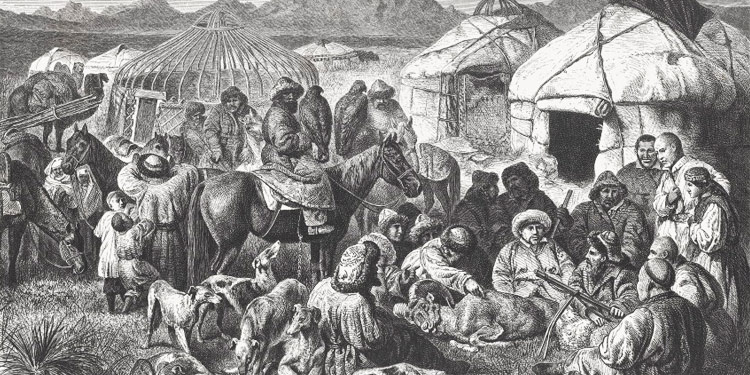History of Kyrgyzstan

The history of Kyrgyzstan covers ancient petroglyphs to the Silk Road, from the Soviet Union to an independent country. Kyrgyzstan has long been a historically important point in the center of Asia, at the confluence of trade routes and empires. Located right between the Chinese, Persian, Arab, Indian, Turkic, and Russian empires, the land that today forms Kyrgyzstan has changed the history of many peoples, religions, cultures and travelers.
Central Asia and the areas around the Tian Shan have been inhabited for thousands of years, as petroglyphs and archaeological finds can attest. Osh, in southern Kyrgyzstan, is one of the oldest settlements in Central Asia, and has been known since antiquity. Some of the earliest settlers were nomadic pagans who practiced Tengrism, an ancient monotheistic religion centered around nature. Up until the Battle of Talas, between the Chinese Tang dynasty and the Arab Abbasid Caliphate in 751 CE, Central Asia was a largely Buddhist territory, though certainly other religions and cultures were well known because of travelers on the Silk Road. The Battle of Talas marked a turning point, from which Islam starting becoming the dominant religion and influence on the region. The Karakhanids were one of such early Muslim dynasties, and they mixed many older Turkic elements with Islam. The Karakhanids were in power from the 9th to 11th centuries, during which time they built Burana Tower (all that’s left of their capital, Balasagun) and the mausoleums in Uzgen.
Starting in the 13th century
Starting in the 13th century with the Mongol conquest sweeping across Asia, the people that became today’s ethnic Kyrgyz moved from the Yenisei River, in Siberia, to their current home in the Tian Shan. The Tian Shan remained under the control of the Mongols in various forms for several hundred years, including under the Kalmyks, the Oirats, and the Dzungars, depending on who had recently beaten whom.
18th century

In the 18th century, the Qing Dynasty in China had reached its largest size, and the Oirats became a vassal state. With the rise of the Khanate of Kokand in the early 1700s, Kyrgyzstan fell under the rule of the Khanate. Throughout these previous centuries of Kyrgyzstan’s history, the area played a vital role as a stop for travelers on the Silk Road crossing Asia. Visitors can still see Tash Rabat, a stone caravanserai (like a hotel) in Naryn Province, dating from the 15th century. There are also influences from many lands that entered the languages and cultures (and even DNA) of the people living in the area, likely from passing merchants and travelers. And although the Epic of Manas is reputed to be much older, the events that it depicts closely match the history of the 16th and 17th centuries.
Central Asia was right in the middle of the Great Game of imperial expansion in the 1800s, played out between Russia from the north and Great Britain from the south. At this time, the Khanate of Kokand was much weaker, and so smaller regional rulers had significantly more power. When Alimbek Datka, who was the ruler of the Alai (in what is now southern Kyrgyzstan), was murdered in a palace coup, his wife, the strong Kurmanjan, became the newest leader in 1862. As the Russians moved closer and closer, Kurmanjan Datka urged a peaceful transition, and in 1867, the Alai region was annexed by the Russian Empire. A 2014 film shows the story of her life (as well as the stunning landscapes that she lived in), which is now considered to be an important part of the history of Kyrgyzstan.
1867 to 1918
From 1867 to 1918, Kyrgyzstan was part of Russian Turkestan, a Governor-Generalship in the Russian Empire. Turkestan remained a colonial outpost for many years, isolated by distance from the capital in Saint Petersburg, but the advent of railroads at the turn of the 20th century brought more and more Russian settlers, straining limited land and water resources. This led to the Basmachi Revolt in 1916, followed by harsh Russian reprisals. Many Uzbeks, Kazakhs and Kyrgyz fled across the border to China, both following the 1916 revolt and the forceful arrival of the Communist Party in 1918.
Soviet Union

Following the establishment of the Soviet Union in 1917, Turkestan was divided up into oblasts, roughly according to ethnicity. Since many people were nomadic, and many people identified more with their religion, city, or profession, than with ethnicity, borders were hard to draw, and many populations ended up outside of their titular nation (this is why there is a large population of Uzbeks in southern Kyrgyzstan today). The Kara-Kirghiz Autonomous Oblast was established in 1924, only to be replaced by the Kirghiz Autonomous Socialist Soviet Republic, in 1926. Both of these bodies were part of the Russian Socialist Federative Soviet Republic. In 1936, the Kirghiz Soviet Socialist Republic was established, governed by the Kirghiz branch of the Communist Party from the capital in Frunze, now Bishkek. One of the most notable figures to come from Soviet Kyrgyzstan was Chingiz Aitmatov, a famous politician, diplomat, and writer.
The 90s and Beyond

On August 31, 1991, the Republic of Kyrgyzstan declared independence from the Soviet Union. The president since 1990, Askar Akayev, became President of the new republic, and stayed in office until the Tulip Revolution in 2005. Politics remained unstable until protests in 2010 led to the ouster of Bakiyev, who had replaced Akayev. Tensions flamed into violence along ethnic lines between Kyrgyz and Uzbeks in Osh, recalling similar riots that broke out in Osh in 1990. Roza Otunbayeva became interim president in April 2010, also becoming one of the few female leaders in a Muslim-majority country. She also became the first Kyrgyz leader to peacefully hand over power when she stepped down after elections that brought Almazbek Atambayev to the presidency in 2011. Since then, Kyrgyzstan has stayed relatively stable, even hosting two World Nomad Games, in 2014 and 2016.












